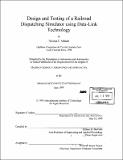Design and testing of a railroad dispatching simulator using data-link technology
Author(s)
Malsch, Nicholas F. (Nicholas Fred-Albert), 1975-
DownloadFull printable version (47.63Mb)
Advisor
Thomas B. Sheridan.
Terms of use
Metadata
Show full item recordAbstract
Prior research has established the need for a more efficient communication environment than the radio environment in the railroad industry and particularly for the dispatching task. Data-link technology has been introduced successfully in the aviation world and greatly improved the communication environment. The objective of this research was to examine the primary consequences as well as the side effects of the use of data-link as an alternative communication channel for dispatchers. Human-in-the-loop experiments were run on the MIT/Volpe National Transportation System Center dispatching simulator. The primary goal was to see whether the introduction of a data-link system improved the dispatching environment in terms of safety, communication efficiency and productivity. Secondary goals included trying to understand how the introduction of data-link technology would affect the dispatcher's task and strategies. Two data-link systems were designed and tested: a directed system with no broadcasting capacity and a broadcast system. Both were found to be highly efficient communication tools if used in addition to the radio. The results of this experiment suggested that an ideal communication environment for dispatchers should include a radio/data-link combination, where the radio would be used for simple or urgent transmissions and the data-link system for more complex safety-critical messages. In terms of safety measure, both data-link environments clearly proved superior to the current radio environment by itself. Safety of maintenance workers was equally greatly improved by both data-link systems. Train safety however, was improved only when using the data-link broadcast system. No increase in measured dispatching productivity (trains and track maintenance) was observed with data-link. In addition to communication times and railroad safety, data-link seemed to improve the overall situation awareness.
Description
Thesis (S.M.)--Massachusetts Institute of Technology, Dept. of Aeronautics and Astronautics, 1999. Includes bibliographical references (p. 203-204).
Date issued
1999Department
Massachusetts Institute of Technology. Department of Aeronautics and AstronauticsPublisher
Massachusetts Institute of Technology
Keywords
Aeronautics and Astronautics